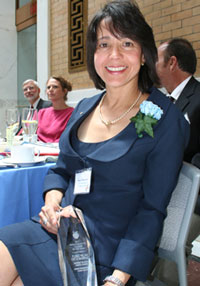Supporting English Language Learners: What Happens When Teaching in Students’ Native Language is Made Illegal?

Floris Wilma Ortiz-Marrero is the first ELL teacher to win the state’s teacher of the year award.
“She told me I’ll be a doctor or astronaut or—both,” said 13-year-old Takuto Kimura at a June ceremony in Boston honoring Floris Wilma Ortiz-Marrero as the Massachusetts 2011 Teacher of the Year, the first ELL teacher to receive that recognition.
The young Kimura, who now speaks English with confidence, arrived from Japan three years ago in Ortiz-Marrero’s classroom at Amherst Regional Middle School not knowing a word of the language of his new country.
His progress is not an anomaly, says Amherst principal Michael Hayes. According to Hayes, Ortiz-Marrero, who has been a teacher-consultant with the Western Massachusetts Writing Project since 1997, runs a “classroom [where] you will find a nurturing environment that is filled with high expectations for the students.”
Ortiz-Marrero credits the Writing Project with pointing her in the direction that has led to her current recognition. “When I talk about my leadership role, I always begin by giving all the credit to the Western Massachusetts Writing Project. They saw in me what I could have never seen in myself—a teacher-leader whose experience as an ELL teacher they valued.”
It was at the Western Massachusetts Writing Project invitational summer institute that Ortiz-Marrero, who is from Puerto Rico, met the woman who was to become her colleague in many projects, Karen Sumaryono.
“We cocreated, co-led, coauthored articles, and copresented at local state and national conferences. This is what attracted me to the Western Massachusetts Writing Project. The collaborative collegiality that permeated everything we do resonates with my cultural background. It is about the work of teachers teaching teachers; it’s not individual work.”
The respect that Ortiz-Marrero has for the Writing Project is very much reciprocated. Indeed, she was nominated for Teacher of the Year by Western Massachusetts Writing Project colleague and site leader Bruce Penniman, himself a Teacher of the Year in 1998, who says of Ortiz-Marrero, “She’s the complete package.”
“She’s a first-rate teacher who’s done a lot of innovative things for students,” says Penniman. “She’s deeply involved in the community, especially supporting the Latino community. She’s developed programs that have gotten a lot of national recognition.”
New Laws Demand New Approaches
To a degree these programs were the product of necessity. In 2002, Massachusetts passed the English for the Children ballot initiative that made it illegal to teach children in their native language.
“Students who had not mastered English were coming into mainstream classes much sooner,” says Penniman.
So Ortiz-Marrero, working with colleagues at Western Massachusetts Writing Project, began to develop workshops to help teachers who were new to the experience of teaching Russian, Ethiopian, Cambodian, and Puerto Rican immigrants with limited English proficiency (for more, see ELL Professional Development Adapts to New Bilingual Education Legislation).
Much of what she taught teachers wasn’t complicated. She encouraged them to speak slowly, paraphrase confusing material, and allow groups of students to draw pictures to illustrate new vocabulary words.
But she also found creative ways for students to use their first language in her classroom. For instance, she encouraged them to use their native languages when prewriting.
She also understood the importance of encouraging students to preserve their cultural identity as they are learning in English. In an article she and Sumaryono published in the May 2004 edition of Voices from the Middle, Preserving the Cultural Identity of the English Language Learner, she describes a mini-geography lesson in which students point to their country of origin on a world map. She also suggests teachers honor first languages by using different languages to illuminate key words in a lesson.
She knows that working with ELL students is a challenge for both the student and teacher. In working with English-speaking teachers she will present—all in good humor—an entire science lesson in Spanish, helping the teachers better experience what their students are going through as they make the effort to grasp their lessons in a tongue foreign to them.
Speaking Truth to Power
But in receiving the Teacher of the Year recognition, Ortiz-Marrero was being honored as much for her character as for her innovative ideas.
Principal Hayes told the Boston gathering, “She is deeply committed to underrepresented populations and helps keep them central in our thinking.”
He described how she visits students’ homes and gives them rides, and how she connects with all colleagues, parents, and students. “She’s a bridge builder,” he said. “She keeps faculty discussions positive.”
These are talents that Ortiz-Marrero will very much need to call on as she begins her work as Teacher of the Year. While she will remain in her classroom, she will also be expected to “speak for and energize the teaching profession and represent the positive contribution of teachers statewide.”
Ortiz-Marrero sees her new position as a chance to “make visible the work of my colleagues and make a strong statement that students are not empty vessels waiting to be filled. They possess a wealth of knowledge, experiences, and literacies that oftentimes are not congruent with the school’s expectations.”
Words like these support Penniman’s claim that Ortiz-Marrero “has been known to speak truth to power, but always in a respectful way.” She admits to being an emotional person who occasionally needs to curb her enthusiasm to be effective.
But her student Takuto Kimura, for one, has no problem with this enthusiasm: “She just hugs everybody. Big hugs. It makes us feel good. We can’t be sad with her.”

